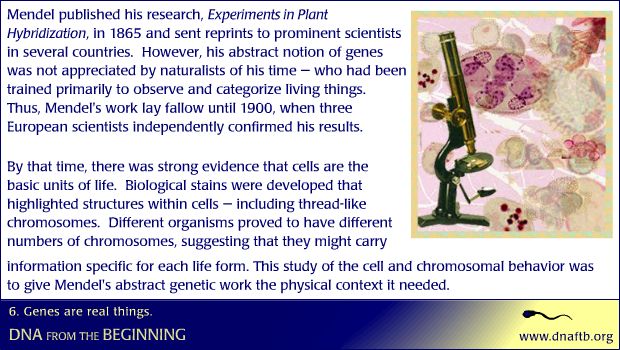Genes are real things.

The study of the cell and chromosomal behavior confirmed Mendel's work.
Mendel published his research, Experiments in Plant Hybridization, in 1865 and sent reprints to prominent scientists in several countries. However, his abstract notion of genes was not appreciated by naturalists of his time — who had been trained primarily to observe and categorize living things. Thus, Mendel's work lay fallow until 1900, when three European scientists independently confirmed his results. By that time, there was strong evidence that cells are the basic units of life. Biological stains were developed that highlighted structures within cells — including thread-like chromosomes. Different organisms proved to have different numbers of chromosomes, suggesting that they might carry information specific for each life form. This study of the cell and chromosomal behavior was to give Mendel's abstract genetic work the physical context it needed.
plant hybridization, biological stains, abstract notion, genetic work, mendel, chromosomes, genes, organisms, naturalists
- ID: 16208
- Source: DNALC.DNAFTB
Related Content
16206. Biography 5: William Bateson (1861-1926)
William Bateson brought Mendel's laws to the attention of English scientists. Bateson and Reginald Punnett co-discovered "coupling," or gene linkage.
16222. Biography 6: Hugo de Vries (1848-1935)
Hugo de Vries, Carl Correns and Erich von Tschermak-Seysenegg were the three scientists who rediscovered Mendel's laws in 1900.
16172. Gallery 3: Gregor Mendel Manuscript, 1865
First page of Mendel's paper (German), Experiments in Plant Hybridization, in his handwriting, 1865.
16209. Genes are real things.
DNAFTB Animation 6: Hugo de Vries, Carl Correns, and Erich von Tschermak-Seysenegg explain the laws of heredity, and Theodor Schwann introduces cellular microscope discoveries.
16151. Biography 1: Gregor Mendel (1822-1884)
Father of Genetics
16735. Concept 36: Different genes are active in different kinds of cells.
Cells differentiate because specific enzymes turn genes on and off in various cell types.
16170. Genes don't blend.
DNAFTB Animation 3: Gregor Mendel explains that breeding short and tall pea plants didn't produce a medium-sized plant.
16223. Biography 6: Carl Correns (1864-1933)
Hugo de Vries, Carl Correns and Erich von Tschermak-Seysenegg were the three scientists who rediscovered Mendel's laws in 1900.
16156. Gallery 2: Gregor Mendel with fellow Monks, 1862
Gregor Mendel and fellow monks, around 1862. Mendel is holding a fuschia sprig - a plant with which he made hybrids.
16205. Biography 5: Reginald Crundall Punnett (1875-1967)
Punnett devised the "Punnett Square" to depict the number and variety of genetic combinations, and had a role in shaping the Hardy-Weinberg law.












